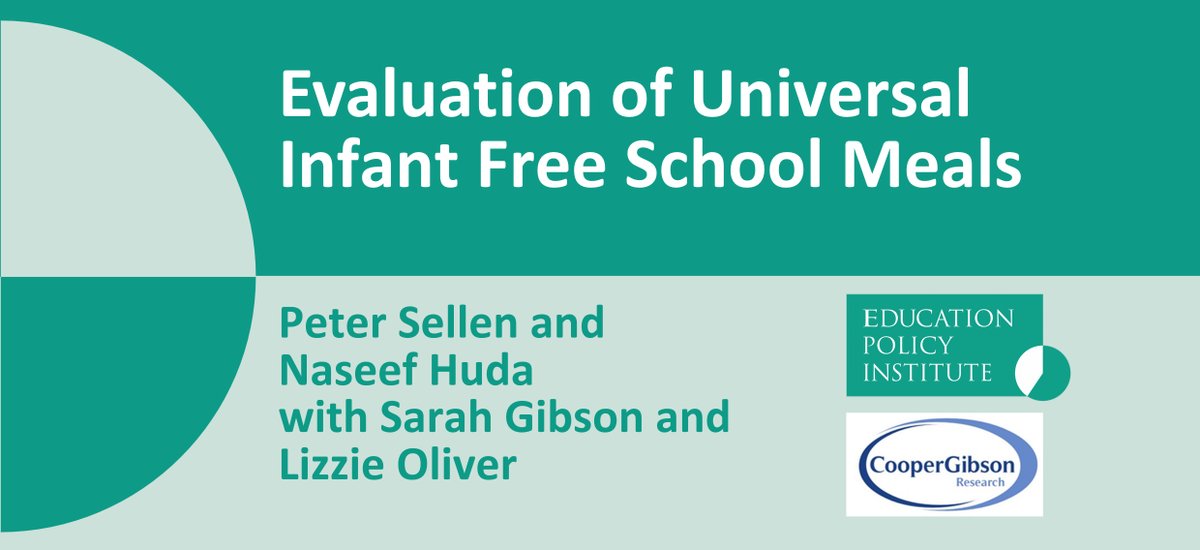In 2014, the Universal Infant Free School Meals (UIFSM) policy was introduced, stipulating that all children in England’s state funded schools in reception, year 1 and year 2 should be entitled to a free school lunch.
This report looks at the impact that the policy has had on take up of school meals, how the policy has been implemented in schools, the costs to government and the cost-savings to parents, and views on the educational, social and health outcomes for children.
Alongside statistical analysis and economic modelling, this research is informed by fieldwork carried out by CooperGibson Research: case study visits to schools, interviews, and surveys of school leaders, teachers, caterers, and parents/carers.

You can download the full report here.
Key Findings
Policy implementation and take-up of school meals
- Based on ONS data, UIFSM led to a rapid increase in school meal take-up (from an estimated 38% in 2013-14 to 80% in 2015-16) and this was reflected across the majority of schools.
- Schools and caterers have incurred significant costs and have made many revisions to the delivery of food to implement UIFSM. There appears to be scope for schools to learn from others’ experience, as many have found solutions to challenges that others have struggled with.
- Most parents are satisfied with the quality of school lunch provision. Schools with better Ofsted inspection outcomes have tended to have higher rates of take-up.
- Despite initial concerns for the ability of small schools to deliver higher levels of take-up, these have not been reflected in the rates reported in the school census for January 2017.
- Urban city and town schools have the lowest take-up rates of UIFSM, at 84%, compared to 87% in rural schools.
- Small schools also have slightly higher take up rates (88%) than schools with over 500 pupils (86%).
Outcomes for pupils and their families
- Parents have cited significant financial benefits as a result of UIFSM and have appreciated the time that has been saved from not having to make packed lunches. (Saving an average of 50 minutes and £10 each week).
- Some, though generally less than half, of the school and parent/carer respondents to surveys have perceived positive impacts in the short term on educational, social and health outcomes, but such effects have not been tested for statistically in this study.
- UIFSM has not, on its own, caused most schools to change their wider food policies but it has often supported, or been a catalyst for, wider efforts to improve the profile of healthy eating in a school, better engage parents and pupils, and develop the school food curriculum.
- Many school leaders believe UIFSM has improved the profile of healthy eating across their school, and many parents feel it has encouraged their children to try new foods and eat more fruit and vegetables (41% of school leaders reported that the general profile of healthy eating across the school had improved as a direct result of UIFSM.)
- Further research may be required to establish whether similar impacts on education are likely to have occurred as were found in the FSM pilots, and whether the perceived benefits for dietary habits, dining etiquette and social skills noted by some respondents have had longer-term impacts.
Aggregate costs and cost-effectiveness
- In a central modelling scenario, the estimated economic resource costs of the policy are smaller than the value of financial and time savings for families (by an estimated net present value of £887m, over a 10-year period), making UIFSM a potentially cost-effective educational intervention on these terms.
- This is dependent on seeing the impacts observed in the FSM pilots replicated, on achieving economies of scale in production, and on maintaining quality in school food provision. School leaders and caterers should reflect on the lessons from this study, and the examples of alternative delivery approaches from case studies, to make sure this happens.
- However, under any scenario the public sector financial costs are substantial (an estimated total of £5.560bn over a 10-year period), and on these terms the policy’s efficacy would rest on policymakers attaching a high value to improving the living standards of households with infants who were not already eligible for FSM, and on potentially generating health and social benefits.
- So far, the funding of schools to deliver UIFSM appears to have been adequate on average, but a small proportion of schools have seen an increase in deficits in school meal provision.
- On reasonable assumptions of future cost inflation the current funding rates applied by the Department for Education are likely to become insufficient. Under this scenario, the net costs to schools – and the existing impacts on wider curriculum delivery and school staff time – will be increased, potentially undermining wider benefits that might be realised.
- The policy has also affected Pupil Premium funding for infants, which may affect the same children in later years. (31% of school leaders surveyed reported that take-up of FSM for pupil premium purposes had decreased, 15% reported that it had increased and 38% reported that it had stayed the same due to UIFSM).
- The Department for Education should monitor the implications for funding and school accountability, and consider ways to make it easier for parents to be registered for the Pupil Premium under Universal Credit.
